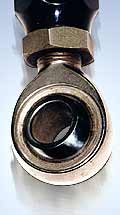
The other type of liner “beating out”
failure involves the physical bond between the
liner and the race. The self-lubricating nature
of the liner sometimes makes it difficult to
bond to the race. If the manufacturer can’t
make this bond sufficiently strong, then the
liner will become detached from the race. Each
time there is a misalignment of the rod end
(more on this later), pieces of the liner will
disintegrate. The end result will be a rod end
with clearances that prove excessive. Aside
from government MIL Specs for Teflon-lined bearings,
there are no standards set for liner bond strength.
Of course, if a rod end manufacturer can meet
this standard and manufactures a line of bearings
approved for military use, then there’s
a good chance that their high quality Teflon-lined
race bearings also use this same manufacturing
criteria.
Aligned Or Misaligned?
What is rod end “misalignment” all
about? Remember when we pointed out the basics
of rod end design (the sphere inside the race)?
Basically, it’s no secret that a bolt or
fastener of some sort goes through the hole
bored through the center of the rod end. Because
of this, it’s obvious that it cannot rotate
inside the housing a full 360 degrees (without
the fastener through the center, the ball can
rotate through a full circle). Given this fact,
all rod ends have limitations in regard to how
far they can be misaligned before the sphere
binds in the housing. The angle of misalignment
is a crucial factor when selecting rod ends.
Not all rod ends can accept the same degree
of misalignment as others. If you exceed the
manufacturer’s recommended maximum angles,
the smallest thing you’ll find is premature
rod end wear. On the other end of the spectrum,
the worst thing you’ll find is outright
rod end failure.
 Take
a close look at this rod end. See how the “ball”
isn’t centered? This is the “misalignment”
that the rod end design can handle. Check the
manufacturer’s recommended maximum angles
in their respective catalog, then order the
right bearings (different rod ends have different
misalignment tolerances). The text offers info
on measuring misalignment (it’s simple
stuff). Take
a close look at this rod end. See how the “ball”
isn’t centered? This is the “misalignment”
that the rod end design can handle. Check the
manufacturer’s recommended maximum angles
in their respective catalog, then order the
right bearings (different rod ends have different
misalignment tolerances). The text offers info
on measuring misalignment (it’s simple
stuff).
So how do you know how much the angle of misalignment
really is? To measure the angles mandated for
the application, use a good old-fashioned protractor
to dimensionally check the geometry. You’ll
find that this angle of misalignment is specified
in all rod end catalogs (at least those who
manufacture quality rod ends). Comparing your
measured angles to those in the catalog, you’ll
be able to select the right rod end for the
application. The biggest mistakes you can make
are to shortcut this measurement and to buy
a rod end that simply looks big enough to handle
the job.
That’s just the beginning when it comes
to rod ends. Next issue, we’ll dig deeper
into the world of spherical bearings. You might
be surprised at what you see.
| Source |
Aurora
Bearing Company
970 S. Lake Street
Aurora, IL 60506
PH: 630-859-2030 |
Jerry
Bickel Race Cars
141 Raceway Park Drive
Moscow Mills, MO 63362
PH: 636-356-4727 |
|